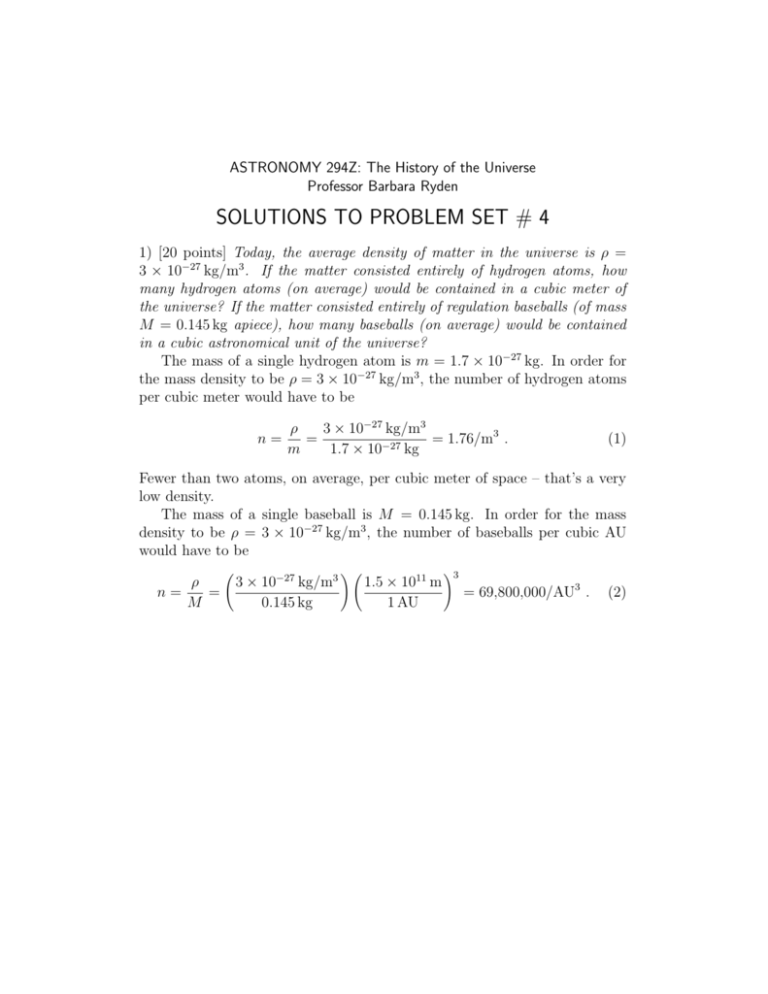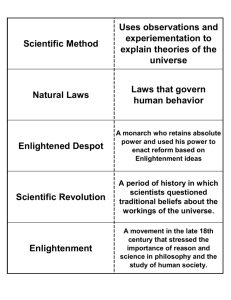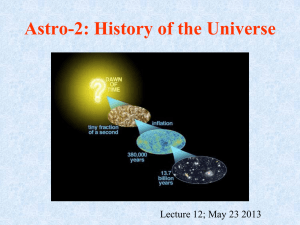SOLUTIONS TO PROBLEM SET # 4
advertisement

ASTRONOMY 294Z: The History of the Universe Professor Barbara Ryden SOLUTIONS TO PROBLEM SET # 4 1) [20 points] Today, the average density of matter in the universe is ρ = 3 × 10−27 kg/m3 . If the matter consisted entirely of hydrogen atoms, how many hydrogen atoms (on average) would be contained in a cubic meter of the universe? If the matter consisted entirely of regulation baseballs (of mass M = 0.145 kg apiece), how many baseballs (on average) would be contained in a cubic astronomical unit of the universe? The mass of a single hydrogen atom is m = 1.7 × 10−27 kg. In order for the mass density to be ρ = 3 × 10−27 kg/m3 , the number of hydrogen atoms per cubic meter would have to be n= 3 × 10−27 kg/m3 ρ = = 1.76/m3 . m 1.7 × 10−27 kg (1) Fewer than two atoms, on average, per cubic meter of space – that’s a very low density. The mass of a single baseball is M = 0.145 kg. In order for the mass density to be ρ = 3 × 10−27 kg/m3 , the number of baseballs per cubic AU would have to be ρ n= = M Ã 3 × 10−27 kg/m3 0.145 kg !Ã 1.5 × 1011 m 1 AU !3 = 69,800,000/AU3 . (2) 2) [20 points] The temperature of the cosmic background light today is T ≈ 3 K. At the time the universe became transparent, the temperature of the cosmic background light was T ≈ 3000 K. This means that the universe has expanded by a factor of 1000 since it became transparent. If the density of matter today is ρ = 3 × 10−27 kg/m3 , what was the density of matter when the universe became transparent? Consider a cube that is expanding along with the general expansion of the universe. The edges of the cube currently have a length `now = 1 m. The volume of the cube is `3now = 1 m3 , and thus the mass it contains is M = ρnow `3now = 3 × 10−27 kg. Since matter is not created or destroyed, the mass M inside the cube remains constant as the universe expands. At the time the universe became transparent, the expanding cube had sides of length 1m `now = = 0.001 m . (3) `trans = 1000 1000 The density within the box when the universe became transparent was ρtrans = M `3trans = 3 × 10−27 kg 3 × 10−27 kg = = 3 × 10−18 kg/m3 . (0.001 m)3 10−9 m3 (4) If lengths in the universe increase by a factor of one thousand, then the density of matter decreases by a factor of one billion. 3) [20 points] At the time of primordial nucleosynthesis, the temeprature of the cosmic background light was T ≈ 4.8 × 108 K. By what factor has the universe expanded since the time of primordial nucleosynthesis? If the density of matter today is ρ = 3 × 10−27 kg/m3 , what was the density of matter at the time of primordial nucleosynthesis? The temperature at the time of primordial nucleosynthesis was Tnuc = 4.8 × 108 K. The temperature now is Tnow = 3 K. The universe has expanded by a factor of Tnuc 4.8 × 108 K = = 1.6 × 108 (5) Tnow 3K since the time of primordial nucleosynthesis. That is, a cube that currently has sides of length `now = 1 m had sides of length `nuc = 1m `now = = 6.25 × 10−9 m . 1.6 × 108 1.6 × 108 (6) Using same argument as in the previous problem, we deduce that the matter density at the time of primordial nucleosynthesis was ρnuc = 3 × 10−27 kg M = = 0.012 kg/m3 . `3nuc (6.25 × 10−9 m)3 (7) 4) [20 points] Look up the density of the Earth’s air at sea level. Is the density of matter at the time of primordial nucleosynthesis greater than or less than the density of the Earth’s air at sea level? According to the Wikipedia article “Density of Air”, dry air has a density ρair ≈ 1.2 kg/ m3 at sea level at a temperature T = 20◦ C = 68◦ F . (It becomes denser when cooler, and less dense when warmer.) Thus, the density of matter at the time of primordial nucleosynthesis is less than the density of the Earth’s air at sea level, by a factor of a hundred. (Although the universe started out in an extraordinarily dense state, by the time several minutes have passed since the Big Bang, the density of matter has dropped to something that’s not outlandishly high, by terrestrial standards.) 5) [20 points] Suppose that you have used a Cepheid variable star as a “standard candle” to compute the distance to a particular galaxy. The distance computed is d = 35 Mpc. Much to your embarrassment, you find that the Cepheid variable star has a luminosity L that is actually twice the luminosity you assumed when making your calculation. Is the galaxy closer or farther than you originally calculated? What is the true distance to the galaxy? For a standard candle of assumed luminosity L and measured flux F , the distance is s L . (8) d= 4πF When you increase your assumed luminosity L, you increase the computed distance; thus, the galaxy is farther than you originally calculated. Originally, using a false luminosity Lfalse , you computed dfalse = s Lfalse = 35 Mpc . 4πF (9) However, the true distance, using the correct luminosity Ltrue = 2Lfalse , is dtrue = s Ltrue = 4πF s 2Lfalse √ = 2× 4πF s Lfalse . 4πF Comparing equation (10) with equation (9), we find that √ √ dtrue = 2 × dfalse = 2 × 35 Mpc = 49.5 Mpc . (10) (11)








